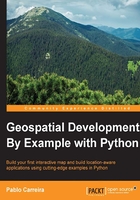
Sort the countries by area size
You programmed three functions so far; now, let's add another one to our list by converting the code that generated a list of country names to a function and add this function to world_areas.py, as follows:
def get_country_names(datasource):
"""Returns a list of country names."""
layer = datasource.GetLayerByIndex(0)
country_names = []
layer.ResetReading()
for feature in layer:
country_names.append(feature.GetFieldAsString(4))
return country_names
Now, we have four functions, which are:
open_shapefiletransform_geometriescalculate_areasget_country_names
All these functions return iterables, with each item sharing the same index on all of them, thus making it easy to combine the information.
So, let's take advantage of this feature to sort the countries by area size and return a list of the five biggest countries and their areas. For this, add another function, as follows:
def get_biggest_countries(countries, areas, elements=5):
"""Returns a list of n countries sorted by area size."""
countries_list = [list(country)
for country in zip(areas, countries)]
sorted_countries = sorted(countries_list,
key=itemgetter(0), reverse=True)
return sorted_countries[:5]
In the first line, the two lists are zipped together, producing a list of country-area pairs. Then, we used the Python list's sorted method, but as we don't want the lists to be sorted by both values, we will define the key for sorting. Finally, the list is sliced, returning only the desired number of values.
- In order to run this code, you need to import the
itemgetterfunction and put it at the beginning of the code but afterfrom __future__ imports, as follows:from operator import itemgetter
- Now, edit the testing part of your code to look similar to the following:
datasource = open_shapefile("../data/world_borders_simple.shp") transformed_geoms = transform_geometries(datasource, 4326, 3395) country_names = get_country_names(datasource) country_areas = calculate_areas(transformed_geoms) biggest_countries = get_biggest_countries(country_names, country_areas) for item in biggest_countries: print("{}\t{}".format(item[0], item[1])) - Now, run the code and take a look at the results, as follows:
Opening ../data/world_borders_simple.shp Number of features: 246 82820725.1423 Russia 51163710.3726 Canada 35224817.514 Greenland 21674429.8403 United States 14851905.8596 China Process finished with exit code 0